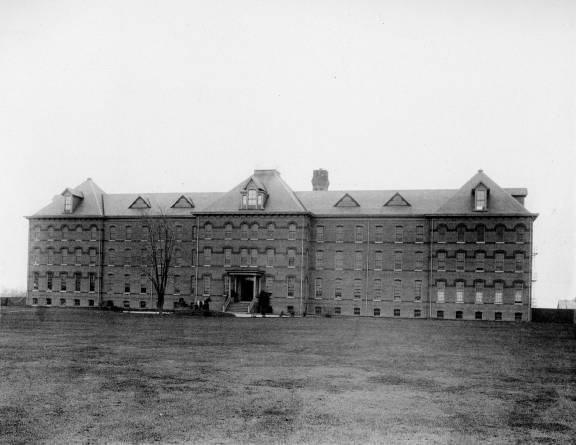Delaware
Number of victims
There
were 945
sterilizations in Delaware. Of
the
victims, 50% were female and 50% were male. Close to
one
third of those sterilized were considered mentally ill, while
more than two thirds were
considered mentally
deficient. Delaware
ranks 13th
in the United States for number of documented sterilizations.
Period during which sterilizations occurred
Sterilization
in
Delaware occurred between 1923 and 1963.
Temporal pattern of sterilization and rate of sterilization

After
passing a
sterilization
law in 1923, Delaware’s sterilization rate initially rose quite
rapidly. The
highest rate of sterilizations took place from 1927-1937, where
approximately
44 people were sterilized per year. Between the 1940’s and 1950’s the
rate fell
slightly to about 25 people per year. From 1950 to 1963, the
sterilization rate
was lower; around 10 people were sterilized annually.
During the peak sterilization time of 1927 to1937,
Delaware sterilized an average of 18 people per 100,000 state
residents
per year.
Delaware was the “highest per capita
state in the nation in utilizing its sterilization law for several
years
through 1949” (J. Paul, p. 321; Stern, p. 1137 n. 2).
Delaware sterilizations continued long past
WWII. 30%
of the sterilizations
occurred after the war, and Delaware was ranked as having the highest
sterilization rate in the country in both the late 1940’s as well as
1962-1963
(J. Paul, p. 321; D. Paul, p. 97).
Passage of laws
In
1918 some
residents of Delaware were troubled by the fact that they were "one
of
the few states in the union which has no provision for its
feebleminded" (American Genetic Association).
The
first sterilization law in Delaware was passed in 1923 (Landman, p.
82). The
first amendment to this law was made on April 10, 1929. The amendment
added “habitual
or confirmed criminals who have been convicted of at least three
felonies
either in federal or state court, either inside Delaware or elsewhere,
if their
criminality was considered due to mental abnormality” (Painter). This created an opportunity
for any criminal
act to be attributed to a mental defect in the offender. An additional
amendment
also made in 1929, included in Section 4, stated that “chronic or
recurrent
insane persons at large are amenable to compulsory sterilization”
(Landman, p.
83). The sterilization law in Delaware has never been tried in court
and has yet
to be repealed (Painter).
Groups identified in the law
Delaware
sterilization
laws included habitual criminals, those who were “chronically insane”,
homosexuals, inmates of mental institutions who were “insane, feeble
minded or
epileptic”, and “those committing criminal acts in or outside of
Delaware as a
result of mental defectiveness (Landman, pp, 82-3; Painter).
Process of the law
With
application
by the superintendent of state institutions, any “insane, feeble
minded
or
epileptic person” could be recommended for “special examination with a
view to
his or her sterilization” (Landman, p. 83). The patient
must have “full
knowledge and understanding of the alternatives to sterilization,
ability to
understand information, and the understanding that they can withhold
consent at
any time,” according to the state statute
(http://delcode.delaware.gov/title16/c057/index.shtml),
but
many patients were likely coerced into their decision to choose
sterilization. The
petition went to the Department of Public Welfare which employed an
examining committee comprised of a physician, an alienist [a mental
health
professional such as a psychiatrist], and the superintendent of the
institution
who would be in charge of conducting the investigation to determine
whether
sterilization would occur (J. Paul, p. 313). This committee had to
decide
unanimously, which they often did, that procreation is inadvisable for
the patient.
If unanimity was reached, the commission would request that the
Department of
Public Welfare order the sterilization of the patient. While the law
stated
that a notice should be sent to the family at least 30 days prior to
sterilization to inform them of the committee’s decision, there was
considerable confusion in Delaware about the necessity or
existence
of
these notices (J. Paul, p. 313).
For being one of the smallest states in the United States, Delaware was remarkable in that during peak times it had the highest per capita sterilization rates in the country. Several factors might have contributed to Delaware taking a lead role in sterilizations. As Julius Paul noted, there was no judicial review of sterilization orders, and the law was compulsory and extramural in its coverage (p. 313). The order for sterilization came from the Dept. of Public Welfare, which “usual[ly]” approved a unanimous determination by an examining commission upon application from the superintendent of a state institution. Once a sterilization had been ordered, there was only notice to be given but no avenue provided for appeal by, e.g., relatives. Paul refers to a superintendent of a state hospital in the 1960s, Dr. Bush, as having noted in a letter to him that no family ever had gone to court to stop the proceedings (J. Paul, p. 317).
Precipitating factors and processes
There
is very
little information on the factors and events that led up to the
passage
of a
sterilization law in Delaware. However,
it did occur during a time of moral panic about the rapid immigration
of people
from eastern and southeastern Europe (Kline, p. 9), but the relation
between
increased immigration and the passage of Delaware’s sterilization law
is
unknown.
Groups targeted and victimized
Those
considered
mentally ill or mentally deficient were sterilized more than any other
group. Out of the
945 sterilizations,
919 of the people sterilized were believed to have been performed on
mentally
ill or “mentally deficient” persons.
The
distribution between total sterilized men and women is equal in
Delaware, but
when viewed separately, 75% of the mentally ill were male, while 60%
of
the
mentally deficient were female. Homosexual
men
were also victimized because they were considered to be suffering
from a
mental deficiency. After being arrested for taking part in homosexual
activity,
many were sent to mental institutions where they could be
involuntarily
sterilized (Painter).
Other restrictions placed upon those identified in the law
Delaware
was
considerably strict on the illegality of homosexuality, and arrested
and tried
many in both local and State Supreme Court cases to punish the
offenders. The
issue of homosexuality was dealt with labeling it as a mental
defect,
therefore allowing for the arrest and incarceration of gay men in
institutions for the "feebleminded" (Painter). By
law,
Delaware had also prohibited the marriage of two “poor people”
(Kevles). Additionally, laws existed preventing the
marriage of
the
insane, or those who had been in an insane asylum. These marriages
were
voidable at the request of the "innocent party" (Schuler, p.
312).
Major proponents
Emma
O. Lundberg
conducted the Social Study of Mental Defectives in New Castle County,
Delaware,
in 1920. She worked
for the Children’s
Bureau of the Department of Labor and alongside Dr. E. H. Mullan.
Together they
conducted mental examinations of school children to identify
“defectives”
(Eugenics Record Office). Later proponents include Dr. Charles K.
Bush,
who was
the Superintendent of the Delaware State Hospital at Farnhurst in the
early 1960s,
and Edgar Hare, the Director of the Department of Public Welfare. Dr.
Charles
Bush stated that “knowing that it would be possible to release more
patients to
their families if they had been sterilized, I began to push the matter
and more
operations were done” (J. Paul, pp. 314, 323).
Feeder institutions
The Hospital for the Mentally Retarded at Stockley and the Delaware State Hospital for the Insane are two places that housed patients who were sterilized. The State of Delaware acknowledges the existence of sterilization records for these two hospitals, but the records remain confidential (State of Delaware, Department of State).
The
Hospital
for the Mentally Retarded at Stockley
housed
patients with mental disabilities and was a
location where sterilizations took place. It now has the name Stockley
Center and
continues to house those with disabilities today, providing
“habilitative
training, health care, family services, and residential services for
individuals with developmental disabilities” (State of Delaware,
Delaware
Health and Social Services).
 (Photo
origin: State of Delaware; available at
http://archives.delaware.gov/exhibits/photograph/arcweek/1890s-32.shtml)
(Photo
origin: State of Delaware; available at
http://archives.delaware.gov/exhibits/photograph/arcweek/1890s-32.shtml)
The
Delaware State
Hospital for the Insane, at Farnhurst (above), is
also
listed as one of the places with sterilization records. The
Hospital
continues to function today as a general hospital. The Mental
Hygiene
Clinic and a Psychiatric
Observation Clinic were also established at the Farnhurst site.
Other
institutions
in the state of
Delaware included Sussex
County
Insane Department; Governor Bacon
Health Center; the Day Care
Center at Dover; and the Mental Hygiene Clinic at Fernhook.(State
of
Delaware Public Archives, Agency Histories).
Many
of
these hospitals are still open today. They no longer perform
sterilizations, but in some cases are still mental health facilities.
None of the hospitals’
websites mentions sterilizations taking place there.
Bibliography
American Genetic Association. 1918. "Feeblemindedness in Delaware." The Journal of Heredity 10: 45-48.Brown, Frederick W. 1930. “Eugenic Sterilization in the United States. Its Present Status.” Annals of the American Academy of Political and Social Science, 149, 3: 22-35.
Eugenics Record Office. 1918. “Defectives in Delaware.” Eugenical News 3: 8.
Kevles, Daniel. “The Great White Way: Daniel Kevles on the History of Eugenics in the US.” Stay Free! Available at <http://www.ibiblio.org/pub/electronic-publications/stay-free/archives/22/eugenics-daniel-kevles.html >.
Kline, Wendy. 2001. Building a Better Race: Gender, Sexuality, and Eugenics from the Turn of the Century to the Baby Boom. Berkeley: University of California Press.
Landman, J. H. 1932. Human Sterilization: The History of the Sexual Sterilization Movement. New York: MacMillan.
Painter, George. 2001. “The Sensibilities of Our Forefathers: The History of Sodomy Laws in the United States: Delaware.” Available at <http://www.glapn.org/sodomylaws/sensibilities/delaware.html>.
Paul, Diane B. 1995. Controlling Human Heredity: 1865 to the Present. New Jersey: Humanities Press.
Paul, Julius. 1965. "'Three Generations of Imbeciles Are Enough': State Eugenic Sterilization Laws in American Thought and Practice." Washington, D.C.: Walter Reed Army Institute of Research. Available at
Schuler, Ruth Velma. 1940. “Some Aspects of Eugenic Marriage Legislation in the United States.”b The Social Service Review 14, 2: 301-316.
State of Delaware. Delaware Health and Social Services: Division of Developmental Disabilities Services. “Stockley Center.” Available at <http://www.dhss.delaware.gov/dhss/ddds/stockley.html>
State of Delaware. Department of State: Delaware Public Archives. “Records of the Delaware Industrial School for Girls” Available at <http://archives.delaware.gov/collections/guide/1500s/1501-000-036.shtml>
State of Delaware. Department of State: Delaware Public Archives. “Woodshaven Kruse School Time Capsule Records” Available at <http://archives.delaware.gov/collections/guide/1500s/1501-000-035.shtml>
State of Delaware. Department of State: Delaware Public Archives. “Sterilization Files.” Available at <http://archives.delaware.gov/collections/guide/1500s/1500-019-038.shtml>.